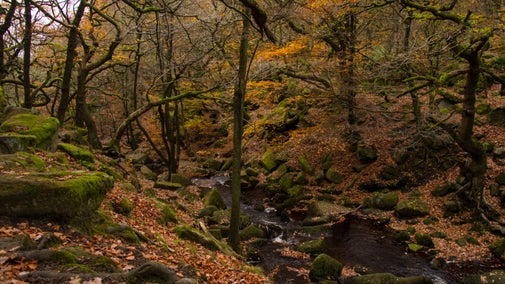
Discover more at Longshaw, Burbage and the Eastern Moors
Find out how to get to Longshaw, Burbage and the Eastern Moors, where to park, the things to see and do and more.

Bole Hill is a now quiet corner of Longshaw, covered by silver birch trees and a haven for wildlife. But 120 years ago the landscape was dominated by an industrial quarry, producing stone for the nearby Howden and Derwent Dams. Discover the history of the quarry and its bustling community of workers and locals here.
It’s hard to imagine Bole Hill as a noisy, dangerous and heavily industrial place, but up until a hundred years ago a working quarry dominated the landscape and local community.
The quarry is best known as the place that produced stone for building the nearby Howden and Derwent Dams in the 1900s. You can still see the broad, flat tracks where the railways were laid. The steep incline leading down to the railway line, just west of Grindleford Station, was constructed to transport rock away from the quarry, through Bamford and up to the dams.
Volunteer historian Thelma Griffiths has researched the life of the quarry and its workers. The records used here are by kind permission of the Derbyshire Record Office.

Quarry workers lived in tin huts, each of which housed a hutkeeper, his family and 10 quarrymen, along with a recreation room and library. Hutkeepers were responsible for keeping their huts in good order, but letters written by Quarry Manager Benjamin Bradley in 1905 suggest this wasn’t always the case:
– Benjamin Bradley, Quarry Manager (1905)
The quarrymen worked between eight and 10 hours a day, depending on the time of year and the hours of daylight. When working hours were shortened, meal breaks were also shorter, although instructions were given that the ‘young persons under eighteen years of age must have their full meal breaks’ – a sign that working conditions were beginning to be taken seriously by employers.
However, many incidents were reported, including several young people being crushed by heavy lifting equipment or hit by runaway train carriages. When 14-year-old Charles was crushed by a counterbalance from a crane, the Sheffield Daily Telegraph reported on 4 July 1904 that ‘The boy’s father saw the accident and fainted at the dreadful sight’.
Quarry life was dangerous, and in 1904, workers went on strike for higher wages. At one time, workers from Wales were brought to replace locals, which caused outcry in the local village of Hathersage.
Before production began it was estimated that the quarry contained 2.4 million tons of building stone, and approximately half of this was removed before the quarry was closed. The National Trust began to look after it in 1954.
Now the quarry is a quiet hillside covered in silver birch trees and home to wildlife such as fly agaric fungi, pied flycatchers and woodpeckers. It’s a great place for walkers, climbers and photographers to imagine the sounds and sights of the past.

Find out how to get to Longshaw, Burbage and the Eastern Moors, where to park, the things to see and do and more.
Discover panoramic countryside views, ancient woodland and heather moorland on a walk at Longshaw. Find out what you’ll see on your next adventure.

Enjoy a brew with a view at the Longshaw Café where you’ll find a range of sandwiches, snacks and drinks, or pop to the second-hand bookshop to discover your next read.

Read about the work going into maintaining the landscape for wildlife and visitors at Longshaw, Burbage and the Eastern Moors.

Learn about people from the past, discover remarkable works of art and brush up on your knowledge of architecture and gardens.
